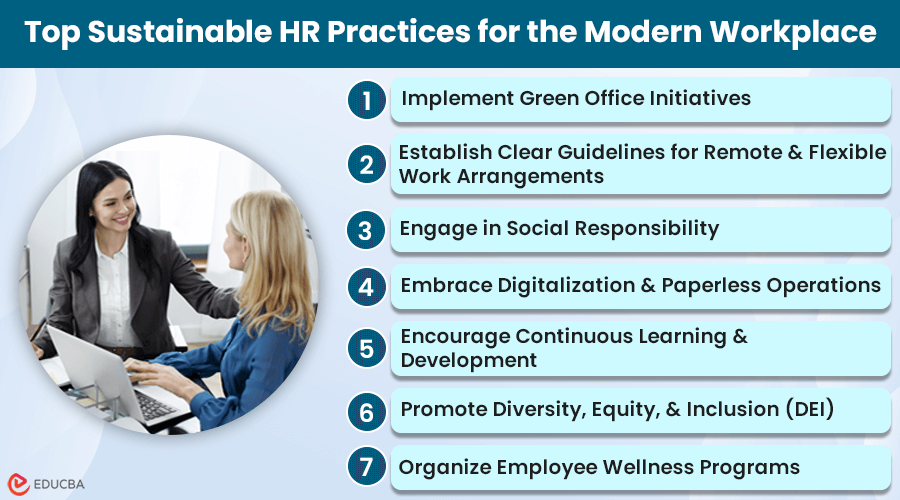
What are Sustainable HR Practices?
Sustainable HR practices refer to human resources management strategies and initiatives to promote environmental, social, and economic sustainability within an organization. These practices integrate sustainability principles into various HR functions such as recruitment, training, performance management, employee engagement, and workplace culture.
The goal is to create a work environment that balances the needs of the organization, its employees, and society in the short and long term.
Sustainable HR practices ensure that your business considers three important things:
1. People
2. Planet
3. Profits
Focusing on these three areas helps protect the earth and makes your company more fair and successful.
In this article, we will look at some of the best ecological and profitable HR sustainability strategies.
Top Sustainable HR Practices for the Modern Workplace
Here are some sustainable HR practices that businesses can implement:
1. Implement Green Office Initiatives
To reduce your company’s environmental impact, start with implementing green office initiatives. This includes setting up recycling programs, using energy-efficient lighting and appliances, and promoting public transportation or carpooling among employees to reduce emissions.
Additionally, ensure that your vendors offer sustainable products and services, covering everything from office supplies to catering. This ensures that your entire supply chain aligns with your sustainability goals.
You can also engage your employees by launching campaigns to promote sustainable practices. For example, departments can compete to minimize energy consumption or waste production for a week. You can then offer rewards such as points redeemable for eco-friendly store gift cards, extra vacation days, or donations to environmental charities in their name.
2. Establish Clear Guidelines for Remote and Flexible Work Arrangements
Having clear guidelines and policies for remote or flexible work arrangements can help reduce emissions and energy consumption, ultimately cutting operational costs.
Therefore, clearly define availability, communication norms, and performance metrics to ensure that remote work runs smoothly. You can train managers on leading remote teams effectively, focusing on setting goals, fostering communication, and building team cohesion. You may leverage one of the best online coaching platforms to create and host suitable training programs.
Establishing regular check-ins or virtual meetings is essential for maintaining team alignment and addressing challenges. Additionally, ensure that reliable technology, including collaboration tools, VPNs, and cloud services, is in place to support remote work.
3. Engage in Social Responsibility
Getting involved in environmental efforts helps tackle local and global issues. It also improves your company’s image and makes employees proud. This attracts socially conscious talent and enhances customer loyalty, possibly opening new markets. To ensure these initiatives resonate, make use of employee voice by actively involving staff in shaping sustainability programs. Gather their insights and suggestions through surveys, focus groups, or informal discussions. This fosters a sense of ownership and strengthens the impact of your social responsibility efforts.
To start, seek strategic partnerships with nonprofits and community groups that share your sustainability goals. Offer structured volunteer programs, including company-wide service days, and give paid time off for participation.
Regular reports on your environmental impact keep people engaged and show your commitment to sustainability. Track metrics like volunteer hours, donations, and carbon footprint reduction, and share summaries on social media.
You can also use AI tools like the LinkedIn summary generator to create impactful messages.
4. Embrace Digitalization and Paperless Operations
Going paperless and switching to digital operations helps the environment and improves organizational efficiency. This is because it reduces waste, preserves trees, and decreases carbon emissions from paper production and disposal. It also makes information and collaboration easier while lowering costs associated with printing and storage.
From transition to digitalization, select user-friendly digital tools that meet your organization’s needs for document management, employee onboarding, training, performance reviews, and communication. Since employees may resist this change, it’s important to introduce a change management strategy to support them. Provide training on using digital tools securely and effectively to ensure a smooth transition.
5. Encourage Continuous Learning and Development
Encouraging continuous learning and development opportunities is important for employee growth. You can create personalized learning plans based on employees’ career goals and areas needing improvement. Moreover, consider offering online training programs, workshops, and seminars covering industry trends, new technologies, and environmental sustainability.
You can also pair employees with mentors for knowledge sharing and professional career advancement. Furthermore, keep track of progress and provide accessible learning resources through a learning management system (LMS) such as Moodle, Blackboard Learn, or Canvas.
This strategy will help your workforce remain competitive. It also builds a company culture of continuous improvement and adaptability, keeping employees motivated.
6. Promote Diversity, Equity, and Inclusion (DEI)
Promoting diversity, equity, and inclusion (DEI) in the workplace fosters a respectful and productive environment. Companies with such a culture tend to have more engaged employees who collaborate effectively and are innovative.
Promoting inclusive policies can help diverse teams bring different perspectives to challenges, leading to more comprehensive solutions. Providing training to raise awareness and reduce unconscious bias is also essential in achieving this goal.
Bias can exist at all company levels, so it’s essential to audit and redesign recruitment processes. This includes having diverse interview panels and implementing structured interviews.
To ensure accountability, establish clear DEI metrics and goals. Forming a DEI committee to monitor progress, oversee initiatives, and gather employee feedback is also important.
7. Organize Employee Wellness Program
Employee wellness programs are essential for long-term sustainability as they promote physical and mental health, reducing absenteeism and boosting productivity. They also lower healthcare costs from a financial standpoint.
These programs should include initiatives to promote sustainable living habits and contribute to environmental sustainability. It consists of a variety of programs focusing on physical, mental, and financial wellness.
It’s beneficial to appoint wellness champions among employees to promote programs, gather feedback, and encourage participation. Regular adjustments to these programs based on survey insights are necessary to address changing employee wellness needs.
Final Thoughts
Sustainable HR practices are more than just a trend; they are essential for thriving workplaces. By implementing strategies for environmental conservation, digitalization, continuous learning, diversity, social responsibility, and employee wellness, you can significantly reduce your ecological footprint while encouraging a healthy and engaged workforce.
This approach is both ethical and financially wise. We recommend taking action, implementing these strategies promptly, and then witnessing your company’s growth and success.
Recommended Articles
We hope this article on ‘Sustainable HR Practices’ was informative and helpful. You can also refer to the articles below for more information.





